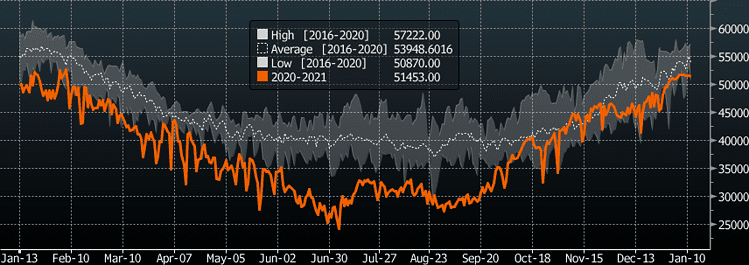Quelle: www.bloomberg.com
-
Widespread sub-zero temperatures across the mainland this week
- Margins squeezed by low wind as chill boosts heating demand
Europe is girding for an extended blast of freezing conditions with temperatures set to drop below zero in many parts by the end of this week.
A sub-zero blast that has already blanketed Madrid in a rare snowfall is set to worsen with a weather phenomenon known as a sudden stratospheric warming. The event can disrupt the polar vortex, the winds that usually keep cold air contained in the far north, and allow freezing weather to head south.
It threatens a re-run of “the beast from the east” of two years ago, when a deadly Siberian cold blast lashed Europe, forcing evacuations, stranding trains and snarling traffic. It couldn’t come at a worse time for the region’s heating and power systems, with calm conditions expected to stifle Europe’s wind generation and nuclear plant outages adding to the strain from the cold.
Chilly conditions in Europe Jan. 17-22 will push the number of heating degree days for that period 11% above the 10-year average, according to weather forecaster Maxar Technologies Inc. The measure of when temperatures are below a level needed to warm buildings is expected to climb to 92 days next week, compared to a 10-year seasonal average of 82.7.
The cold arctic air flow into Europe in January has led to a surge in power demand and has lowered gas storage levels sending prices to the highest for two years.
“It is uncertain how long the cold spell will last and it depends on a number of factors, but at the very least it will last for a week and at the most it could last into the start of February,” Swedish forecaster Klart said on its website.
When margins tighten and renewable output is low, it means more expensive thermal plants will be needed to boost supply. This pushes up prices on the day-ahead and intraday power markets.
It also exposes the markets to risk of price spikes when units are unexpectedly turned off, forcing system operators to activate reserve power plants or ask industry to cut consumption to keep the grid stable.
German day-ahead power prices hit the highest level in two years on Friday with temperatures in Berlin dropping close to freezing.
The coming cold snap could boost prices further with temperatures expected to dip as low as -6.9 degrees Celsius by Sunday in the German capital and to a minumum of -15 degrees Celsius in Helsinki on Friday.
Low availability of Electricite de France SA’s nuclear fleet as the utility carries out maintenance will constrain power supplies for France and its neighbors. France has a much higher level of electric heating than most other European nations and demand is more sensitive to cold weather. The outlook for availability going into February is looking even less positive, according to Glenn Rickson, head of European power analysis at S&P Global Platts.
French nuclear generation is below the five-year average
Kommentar
Leider wenig beruhigende Aussichten aufgrund des schwerwiegenden Zwischenfalls im europäischen Stromversorgungssystem vom vergangenen Freitag. Besonders gefährdet ist nun Großbritannien, wo man bereits mit einem Blackout rechnet. Bereits morgen, Mittwoch, 13.01.21, liegt der Strompreis zwischen 18 und 19 Uhr bei 1.000 Pfund pro MWh (normal deutlich unter 100 Pfund). Das entspricht in etwa 1,12 Euro pro kWh!!!
Siehe auch generell die vergleichbare Situation im Jänner 2017:
- Die „Dunkelflaute“ bringt Deutschlands Stromversorgung ans Limit
- Gewerkschaft: Ende Januar gab es einen Beinahe-Blackout
- Wasserkraft verhinderte Blackout
- Nur knapp am Blackout vorbeigeschrammt?
- Ungewöhnliche Kälte in den letzten Februartagen und zu niedrige Netzfrequenz




Trackbacks/Pingbacks